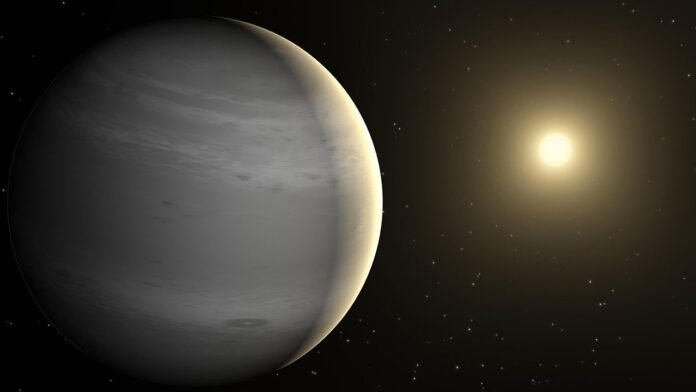
In a groundbreaking discovery, an international team of researchers led by Professor Matthew Bailes of Swinburne University of Technology, Australia, has unveiled a celestial wonder—a planet composed largely of diamond. This extraordinary find, located 4,000 light-years away in the Serpens constellation, offers a glimpse into the exotic and mysterious nature of our universe.
The Discovery of the Diamond Planet
The journey to discovering PSR J1719-1438 began with the detection of a pulsar—a rapidly spinning neutron star—using the Parkes radio telescope of the Australian Commonwealth Scientific and Industrial Research Organisation (CSIRO). Pulsars, typically only about 20 kilometers in diameter, emit focused beams of radio waves as they rotate. These beams create a rhythmic pulsing effect detectable by radio telescopes on Earth.
To further investigate, astronomers turned to the Lovell radio telescope at Jodrell Bank Observatory in the UK and the Keck telescopes in Hawaii. Observations revealed that the pulsar’s radio pulses were subtly modulated, indicating the presence of a small yet dense companion exerting a gravitational influence.
The Binary System and Its Astonishing Companion
The pulsar and its companion planet exist in a binary system, orbiting each other at an astonishingly close distance of 600,000 km—slightly less than the Sun’s radius. The companion orbits the pulsar in just two hours and ten minutes, which is an exceptionally short period.
Despite its small size—less than 60,000 km in diameter, about five times that of Earth—the companion has a mass slightly greater than Jupiter. Given its proximity to the pulsar, a larger companion would have been torn apart by intense gravitational forces.
Origins: A Shrunken Star Turned Diamond
The extreme density of the planet suggests that it is the remnant of a once-massive star that lost most of its material to the pulsar. The pulsar, classified as a millisecond pulsar, spins at an incredible rate of over 10,000 rotations per minute and has a mass of about 1.4 times that of the Sun, despite its compact size.
Scientists theorize that the companion was once a white dwarf—a dense stellar remnant that had its outer layers stripped away, leaving behind an ultra-dense core composed primarily of carbon and oxygen. Given its density, astronomers believe this material must be in a crystalline state, meaning a large portion of the planet is likely similar to diamond.
The Cosmic Rarity of Diamond Planets
This discovery is significant not only for its uniqueness but also for what it reveals about the evolution of binary systems. Dr. Andrea Possenti of the INAF-Osservatorio Astronomico di Cagliari suggests that PSR J1719-1438 and its companion likely evolved from a system known as an ultra-compact low-mass X-ray binary. These rare systems may represent the progenitors of such exotic pulsar-planet formations.
Dr. Michael Keith of CSIRO adds that a planet composed of lighter elements such as hydrogen and helium would be too large to fit within the observed orbit, reinforcing the likelihood of a carbon-based crystalline structure.
Professor Benjamin Stappers from The University of Manchester emphasizes that such planets are exceptional rather than common. “The rarity of millisecond pulsars with planet-mass companions means that producing these ‘exotic planets’ requires very specific conditions,” he explains.
A Landmark Discovery in Pulsar Astronomy
The identification of PSR J1719-1438 was no small feat. The research team analyzed nearly 200,000 gigabytes of data using advanced computational techniques on supercomputers at Swinburne University of Technology, The University of Manchester, and INAF-Osservatorio Astronomico di Cagliari. The study was part of a large-scale pulsar survey involving the 100-meter Effelsberg radio telescope in Germany, one of the most sensitive surveys of its kind.
Professor Michael Kramer of the Max-Planck-Institute for Radio Astronomy (MPIfR) underscores the broader implications: “This is the largest and most sensitive survey of this type ever conducted. We expected to find exciting things, and it is great to see it happening. There is more to come!”
A Redemption in Exoplanetary Science
The discovery of this diamond planet holds a personal significance for Professors Matthew Bailes and Andrew Lyne of The University of Manchester. In 1991, they were part of a team that initially claimed to have found the first exoplanet, a claim later retracted. However, in 1992, astronomers confirmed the first known exoplanetary system around PSR B1257+12, another pulsar.
Now, decades later, Bailes and his team have uncovered one of the most fascinating exoplanets known to date—one that gleams with the brilliance of a celestial diamond, adding another jewel to the crown of astronomical discoveries.
Conclusion: A Cosmic Gem
PSR J1719-1438 stands as a testament to the mysterious and wondrous nature of our universe. A once-massive star, stripped down to its crystalline core, now orbits one of the fastest-spinning pulsars ever observed. This celestial diamond, forged under unimaginable conditions, offers scientists a unique opportunity to understand stellar evolution, planetary formation, and the extreme physics governing pulsar systems.
As research continues, who knows what other cosmic treasures await discovery in the vast expanse of space?

